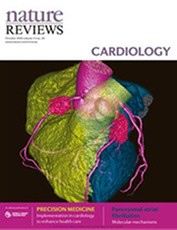Tell us a little about your role and research background?
I am the Chief Editor of Nature Reviews Cardiology, which publishes Reviews, Consensus Statements, opinion pieces, and news articles covering the breadth of clinical cardiology and translational cardiovascular research. Before joining the journal, I studied for a BA in physiological sciences and a DPhil in cardiovascular medicine, both from the University of Oxford, UK. My doctoral research focused on the role of nitric oxide in modulating heart contractility in health and disease.
What do you feel has been the most significant development in cardiovascular research in the past 5 years?
The past 5 years have seen substantial advances in pharmacotherapy in various subspecialties of cardiology: non-vitamin K antagonist oral anticoagulants (NOACs; direct thrombin and direct factor Xa inhibitors) for the prevention and treatment of venous thromboembolism and for stroke prevention in atrial fibrillation; the dual angiotensin receptor–neprilysin inhibitor (ARNI) for heart failure with reduced ejection fraction; and PCSK9 inhibitors for lowering of low-density lipoprotein cholesterol levels. These agents enhance our ability both to reduce cardiovascular risk factor levels and to treat cardiovascular disease.
Can you tell us more about the collection on Cardiovascular disease in women? Why is this collection specifically focused on women and this disease?
Cardiovascular disease (CVD) is the leading cause of death around the world. Prevention, early diagnosis, and effective treatment are important strategies to combat CVD. A complicating factor is that differences exist in the prevalence of particular forms of CVD between women and men. These diseases can also manifest with different symptoms between the sexes, which can lead to underdiagnosis, often in women. Sex-specific considerations and biases are also important in determining the availability and types of treatment received. To draw attention to these disparities, we compiled this collection of Reviews to highlight the sex-specific differences in various forms of CVD, including atrial fibrillation, acute coronary syndromes, microvascular dysfunction, ischaemic heart disease, and heart failure.
What excites you most about the future of research into cardiovascular disease in women?
Improving the prevention, diagnosis, and treatment of cardiovascular disease in women is highly achievable. We already have the diagnostic and therapeutic tools in the clinical armamentarium; we just need to ensure that they are targeted to the appropriate individuals. Campaigns to enhance physician and patient awareness of atypical signs and symptoms of cardiovascular disease in women are on-going and very important to achieve this aim.
Tell us a little about these types of collections and drive behind them at Nature Research?
These collections draw readers’ attention to cutting-edge content from across Nature Research. They allow editors to curate content on a particular theme to highlight an area of rapid development, or a topic of particular public health concern. For example, we have recently also published collections on the immune system in cardiovascular disease and on atrial fibrillation.






